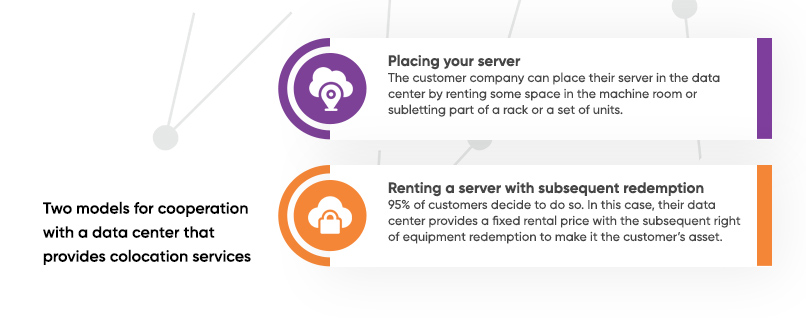Contents
Customers with high requirements for resources and maintenance often choose colocation — placing their own physical server (or rented from a provider) in a data center. This service is highly demanded by fast-growing corporations, small and medium-sized enterprises focused on VOIP, gambling, e-commerce, energy, oil and gas sector, as well as software development companies.
Data centers deal with various server issues and provide:
- electricity (including up to three days with shutdown of diesel generators);
- rooms in line with air conditioning and fire extinguishing standards;
- maintenance;
- high throughput communication channels (with an option to choose network operators);
- backup of business operations;
- advanced security system.
Colocation advantages and disadvantages
Colocation means information and physical security of server equipment, 24/7 technical support and maintenance, easy scalability, control of your IT system, cost savings. Your company takes advantage of the capacities and infrastructure of the data center and at the same time controls its IT systems and has more free space in the office.
In some cases, it is more profitable to increase the operating expenses on colocation in a data center than to constantly cover the capital expenses associated with creating, holding and operating server equipment. You get all the benefits from renting a room in a data center and also finding a comprehensive solution for safe server maintenance.

By hiring remote hands for server maintenance, customers get access to the experience and expertise of data center/service provider employees for prompt resolution of any issues.
Pavel Sabirjanov
Server colocation is relevant for companies with large traffic volumes and huge databases, as well as those who can not have a server room in their office or want to get a backup platform to support their IT infrastructure.
The colocation package includes installation of equipment from any vendor and various performance parameters, except for those with non-standard cooling schemes. This is because of the standards to maintain the optimal temperature for computing equipment in machine rooms.
The main disadvantages of colocation are limited access to the data center, the need to independently purchase, deliver, configure, maintain and dispose of outdated equipment. But it will not be an issue if you manage to find a data center that is ready to take on all the main and additional work.
The final colocation price may include additional payments, it is better to check them in advance. Choose a data center that clearly states all costs from the start: those related to loading and unloading, connection cables, connection work, surcharge on oversized server units or additional network equipment that is too small to occupy a unit (for example, a Wi-Fi router or HTPC). Knowing the amount of costs beforehand provides a better customer experience and helps to plan a colocation budget.
How to choose a colocation data center in Europe
There are two models for cooperation with a data center that provides colocation services: placing your server or renting one with subsequent redemption.
The customer company can place their server in the data center by renting some space in the machine room or subletting part of a rack or a set of units.

What is important when selecting a service provider for colocation
The main pitfalls on the way to creating a reliable server structure in Europe are migration issues and additional payments. It is necessary to choose a data center that takes care of all paperwork, preparation of equipment and its transportation. The best option is finding a data center that covers migration from its start to the end, including migration from other countries, as well as assumes all risks and deals with any emergency issues with no additional payments.
You can rent equipment in a data center with an option to redeem it in 3 to 5 years. 95% of customers decide to do so. In this case, their data center provides a fixed rental price (with no raises throughout the agreement term) with the subsequent right of equipment redemption to make it the customer’s asset. When the customer buys the equipment in their data center, they continue to pay the rental fee (for the number of server units) and electricity fee (as consumed).
Here is an example. A customer from Asia or the United States needs to place servers in Europe, but they can’t deliver their equipment. The data center can create a custom project that involves purchasing equipment for long-term lease with redemption and further migration of all services from the customer’s servers at the software level. The data center employees implement this project from the first to the last step (in some cases even for free).

The data center may also provide 24/7 maintenance support and remote hands if requested. These two super options help the customer to forget about any issues related to the equipment operation.
Olga Boujanova
For example, the customer’s server has been kept in the data center for five years and it is out of warranty at the moment. In this case, technical maintenance is covered by fixed insurance fees stipulated in the contract, which are affordable for the customer.
Insurance means that any failure of the equipment is covered by the provider regardless of the cost of its repair. The customer does not incur any costs for the replacement of components and does not spend time on finding, delivering and installing the failed component. Technical maintenance team performs all the work on a turnkey basis, with no interruptions for the customer.
The second important option is remote hands. IPMI/IDRAC/ILO modules help to connect remotely to the server and create the impression of being directly in the data center. But some of these modules may require additional configuration, primary installation, physical reconnection of the server or racks, i.e. works performed at the hardware level (rearrangement of equipment, configuration of modules), which can’t be done remotely.
In this situation, you need a person who will do all the operations manually. The work is carried out according to the terms of reference issued by the system administrator of the company. Remote hands help with complex infrastructure works: deploy the network infrastructure, get the right IP addresses, configure the network topology or firewall.
Locating a company’s server in a data center is a safe and cost-effective solution that provides simple resource management and business continuity. To select a colocation provider, the following are important:
- Reliability tier (Tier I/II/III/IV) — resilience factor. Tier IV means maximum reliability, but there are not many such data centers (equipment downtime should not exceed 15 minutes per year). Most data centers are Tier III (downtime is not more than 1.6 hours).
- Data center location. Frankfurt (Germany) is the best place for server colocation because it is one of the top 5 largest Internet hubs in Europe. The response time is minimal, and the customer can get to the data center if necessary.
- Rates (flexible/fixed). Flexible rates include free configuration and payment only for the selected (necessary) services. Fixed rates include a set of certain data center services, all extra services need to be paid additionally.

The data center should have an access control system, a biometric control system and 24/7 security service. The customer’s equipment is placed in racks or cages with an individual lock. The customer can ensure short-term access of the technical personnel to the server; after the lock is closed, the access code is automatically canceled.
Pavel Sabirjanov
The placement fee depends on the tier of the data center, the rented space (a whole rack or a set of units), the capacity of the equipment, the width of the Internet channel, the number of IP addresses, the rental period.
What to look for when choosing a data center for colocation in Europe
The choice of a service provider depends on the functionality provided and the options necessary for the customer. As a rule, the service level agreement regulates the relationship with the data center.
Colocation contracts are concluded for 3 to 5 years, so it is important to take into account:
- current requirements of the company and future tasks (transition to a cloud, managed services, work in a high density environment);
- requirements for IT and business (replication, backup, additional sites);
- scaling consistent with future technologies (the service provider should assist in the selection of proper data center space, power consumption increase, communication channels redundancy).
Server infrastructure in Europe with a colocation data center
Write us a message to get additional information.
or book a free consultation
Simple rules for easy colocation:
- it is more profitable to purchase server equipment in the country where the data center is located;
- it is better to purchase new equipment with guaranteed coverage, although it is also an option to install and maintain the old equipment in the data center;
- for equipment migration, hire external contractors or choose a data center that covers this service;
- the site and the supplier are selected by the number of equipment units;
- all arising issues are resolved strictly within the contract framework;
- the price should not be the top priority, the following aspects are even more important: the level of support provided by the service provider, its customer focus, the ability to find a solution for non-standard situations;
- a personal dedicated manager who knows the project and your needs and is focused on successful cooperation. Ticketing systems and company regulations do simplify the work, but people are not robots, so it is always necessary to find out how is personal interaction arranged when choosing a supplier.
We have analysed 20+ providers in Europe: their consumer appeal, the convenience of the server infrastructure and the ease of interaction with the provider, the need for preliminary calculations of operating costs and the complexity of coordination and migration. We summarised our experience in a list of questions you can ask your future provider. Download our checklist here.

Article author
Pavel Sabirjanov
network engineer and a consultant in network design, escalation support, network administration, and systems administration
